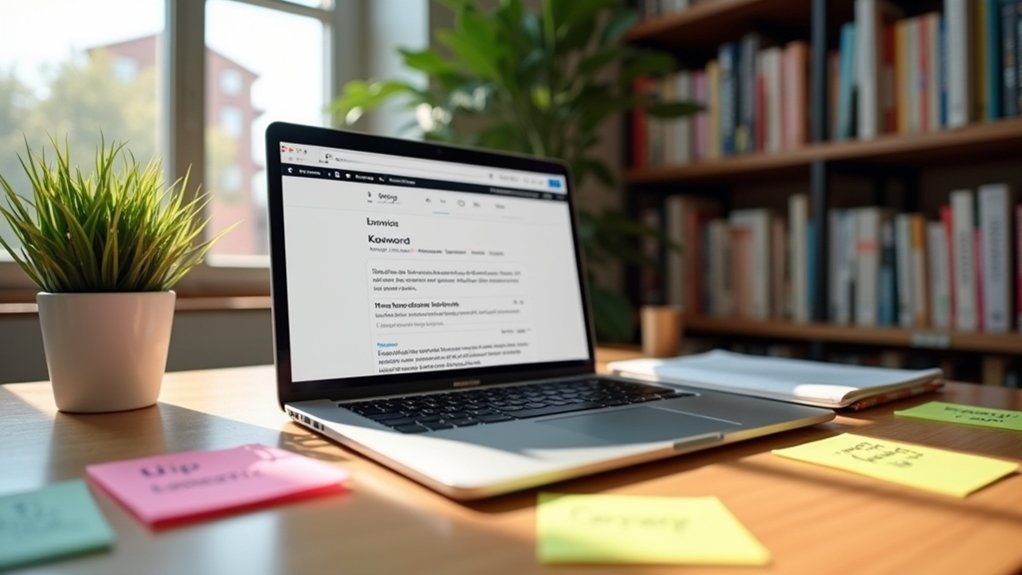![]()

To optimize your blog post for Google, start by researching targeted keywords with tools like Google Keyword Planner, focusing on relevant, low-competition terms. Structure your content using clear headings and short paragraphs for better readability. Incorporate keywords naturally in titles, headings, and meta descriptions to improve visibility. Don’t forget to optimize images and add internal links. Taking these strategic steps boosts your search ranking and audience engagement. Keep exploring these techniques to enhance your blog’s performance further.
Conduct Effective Keyword Research
Anyone looking to optimize a blog post should start with effective keyword research. You’ll want to leverage tools like Google Keyword Planner, SEMRush, or Ahrefs to pinpoint high-volume, low-competition keywords relevant to your niche. Analyze the top search results to grasp user intent, ensuring your content precisely addresses their needs. Develop a list of at least 20 targeted keywords, including variations and synonyms, to broaden reach. Don’t overlook Google’s “People also ask” and “Related searches” to uncover additional queries. Finally, regularly update your keyword list based on performance data and evolving trends to sustain search relevance and authority. Consulting with an SEO agency in Kochi can provide valuable insights and tailored strategies to enhance your keyword research process. Working with a company that offers dedicated executives can ensure that your keyword strategy remains aligned with your business goals and local SEO needs.
Structure Your Content for SEO and Readability

After identifying the right keywords, structuring your blog post strategically guarantees both search engines and readers can navigate your content easily. Use H1 tags for titles, H2 for main subheadings, and H3 for detailed sections to create a clear hierarchy. Break content into short paragraphs—150 to 200 words max—and incorporate bullet points for quick scanning. Seamlessly integrate your keywords in headings and throughout the text without disrupting flow. Employ linking words to enhance coherence and guide readers logically. Aim for thorough coverage with no less than 300 words, optimizing depth to improve search engine ranking and reader retention. Incorporating content optimization techniques from National SEO strategies can further enhance your blog’s performance across diverse audiences. Partnering with a White Label SEO provider can help maintain consistent optimization and scaling of your content strategy efficiently.
Enhance Blog Post Visibility With On-Page Optimization

While crafting quality content is essential, enhancing your blog post’s visibility hinges on effective on-page optimization. You must strategically integrate relevant keywords in titles, headings, and meta descriptions to align with search intent. Employ proper heading structures (H1, H2, H3) to clarify content hierarchy for both readers and search engines. Optimize image alt text and filenames with descriptive keywords to improve accessibility and SEO. Incorporate internal links to related posts, boosting navigation and session duration while distributing link equity. Prioritize high-quality, engaging content that directly addresses user queries to secure favorable search engine rankings.
Frequently Asked Questions
How to Optimize Your Blog Posts for SEO?
You should conduct precise keyword research, structure content with strategic headings, craft compelling meta descriptions, and implement internal links. Consistently analyze performance metrics to refine your approach, ensuring your blog posts achieve maximum SEO impact and visibility.
How Do You Get Your Blog Noticed by Google?
You get noticed by Google by targeting high-impact keywords, crafting compelling titles and meta descriptions, structuring content for clarity, building authoritative links, and consistently analyzing performance metrics to refine your strategy and boost visibility effectively.
How to Optimize SEO on Google?
You should analyze keyword trends, craft compelling meta tags, structure content with clear headings, and integrate authoritative links. Continuously monitor performance metrics via Google Search Console to refine your SEO tactics effectively and maintain competitive advantage.
How Do You Get Your Blog Noticed by Google?
You’ll get noticed by Google by targeting strategic keywords, crafting compelling titles, and ensuring mobile optimization. Consistently update content, build internal links, and leverage analytics to refine your strategy for sustained visibility and authority.
What Are the 3 C’s of SEO?
The 3 C’s of SEO are Content, Context, and Code. You’ll focus on creating relevant material, aligning it with user intent, and optimizing technical elements like site speed and structure to master search engine performance strategically.



